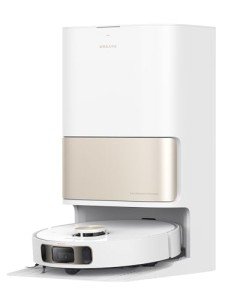Bagless Robot Vacuum Explained In Fewer Than 140 Characters

The Rise of Bagless Robot Vacuums: Revolutionizing Home Cleaning
Over the last few years, home cleaning has progressed considerably with improvements in innovation, particularly in the realm of vacuum. Amongst the most ingenious modifications is the introduction of bagless robot vacuums. These small, automated cleaning devices are created to make maintaining a tidy home more effective and user-friendly. robotic vacuums digs into the features, benefits, and factors to consider of bagless robot vacuums, helping customers make informed decisions about home cleaning options.
What is a Bagless Robot Vacuum?
Bagless robot vacuums are autonomous cleaning devices that operate without the need for traditional dust bags. Instead, they collect dirt and debris in an onboard container that can be emptied when full. This style improves benefit, as users do not need to acquire replacement bags or fret about disposal. They are especially interesting those searching for a low-maintenance cleaning option.
Secret Features of Bagless Robot Vacuums
- Smart Navigation: Bagless robot vacuums use sensors and algorithms to draw up a cleaning area, preventing obstacles and efficiently covering surface areas.
- Arranging Capabilities: Many designs allow users to set cleaning schedules, guaranteeing that floorings are kept even when property owners are away.
- Several Cleaning Modes: They might use numerous cleaning modes for various jobs, such as spot cleaning, edge cleaning, and deep cleaning.
- Self-Charging: Most bagless robot vacuums can go back to their charging stations when their battery is low, ensuring they are constantly all set for cleaning.
- Remote Control: Many designs can be controlled via mobile phone apps, offering users with the capability to begin or stop cleaning sessions remotely.
The following table summarizes some popular designs of bagless robot vacuums and their specs:
| Model | Battery Life | Dustbin Capacity | Smart Features | Price |
|---|---|---|---|---|
| iRobot Roomba 675 | 90 minutes | 0.6 liters | App control, voice assistant | ₤ 299 |
| Eufy RoboVac 11S | 100 mins | 0.6 liters | One-touch control | ₤ 219 |
| Neato Botvac D7 | 120 mins | 0.7 liters | Smart mapping, no-go lines | ₤ 599 |
| Roborock S6 Pure | 150 mins | 0.48 liters | App control, virtual barriers | ₤ 399 |
Advantages of Bagless Robot Vacuums
Bagless robot vacuums use numerous advantages over standard vacuums and bagged designs. Here are some key benefits:
- Cost-Effective: Without the requirement to purchase replacement bags, users can conserve money in the long term.
- Eco-Friendly: The absence of disposable bags means less waste developed, making bagless alternatives a more ecologically friendly choice.
- Effortless Maintenance: Many bagless designs feature washable filters, lowering upkeep hassles.
- Convenient Cleaning: Automated cleaning schedules and hands-free operation considerably reduce the time and effort needed for home cleaning.
- Advanced Features: Bagless robot vacuums often come equipped with contemporary technology, providing different smart features and personalization choices.
Considerations When Choosing a Bagless Robot Vacuum
While bagless robot vacuums offer numerous benefits, there are likewise possible downsides to consider. Here are some elements consumers should consider:
- Dustbin Capacity: Bagless vacuums need regular emptying, specifically in households with pets or high traffic. Buyers need to think about dustbin size relative to their cleaning frequency.
- Suction Power: Not all models offer the exact same suction capabilities. Consumers must try to find vacuums with strong suction for efficient cleaning on different surfaces.
- Sound Level: Some designs might be louder than conventional vacuums. Sound level can be an essential aspect, especially in settings where quiet operation is preferred.
- Floor Types: Users should confirm that the vacuum appropriates for their floor covering combination, such as carpet, wood, or tile.
- Maintenance: Bagless robot vacuums might require regular maintenance, consisting of cleaning brushes and filters, to preserve optimum efficiency.
Frequently Asked Questions about Bagless Robot Vacuums
Q1: How typically should I clear the dustbin of a bagless robot vacuum?
A1: It is suggested to empty the dustbin after every cleaning session, specifically if you have family pets or high traffic areas. Keeping the dustbin less than full makes sure optimum suction and efficiency.
Q2: Can bagless robot vacuums efficiently clean carpets?
A2: Yes, many bagless robot vacuums are designed particularly for carpets and have adjustable suction modes for various floor types. Nevertheless, it is vital to check maker specifications for carpet cleaning capabilities.
Q3: Are bagless robot vacuums appropriate for family pet hair?
A3: Many designs are designed with effective suction and specialized brushes to efficiently get pet hair. Customers ought to look for vacuums particularly marketed as pet-friendly for optimum efficiency.
Q4: How long do bagless robot vacuums usually last?
A4: The lifespan of a bagless robot vacuum can vary, but many models last between 3 to 5 years with appropriate care and maintenance.
Q5: Is it required to change filters in a bagless robot vacuum?
A5: Yes, a lot of bagless robot vacuums have filters that must be replaced or cleaned regularly. robotic vacuum cleaner on sale helps maintain suction and improves air quality.
Bagless robot vacuums have changed the landscape of home cleaning, offering efficient, cost-effective, and ecologically friendly solutions for preserving cleanliness. With features that enhance user experience, these smart devices offer a useful option to traditional vacuum. When selecting a bagless robot vacuum, consumers should consider their particular cleaning requirements and choices, in addition to the vacuum's abilities, to discover the perfect model for their home. As technology continues to advance, the abilities of bagless robot vacuums are likely to progress even more, making them a a lot more valuable addition to modern-day households.

